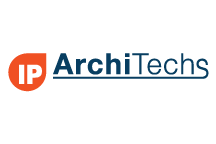Introduction
Do you have a 3 tier, switched, or vendor proprietary data center design?
Does it rely on spanning tree or proprietary solutions to eliminate spanning tree?
Not sure how to migrate to a new architecture without serious downtime?
If you answered yes to any of these questions then this post is for you. We’ll be looking at deploying an EVPN/VxLAN Data Center fabric and migrating from a cisco fabricpath environment to the new design.
Although we will be focusing on a fabricpath migration many, if not all, of the principles apply to migrating a 3 tier architecture.
1. Building the new Data Center Fabric
2. Connecting the current fabricpath and new fabric
3. Migrating switched virtual interfaces
4. Migrating various types of physical devices
Building the new Data Center Fabric
The easiest part of designing and building the new fabric is the physical topology. This should be a symmetric topology to easily take advantage of equal cost multipath and add additional switches with ease. This is also known as a spine/leaf or clos topology. The basic idea is leafs connect to spines and spines connect to super spines. A leaf/spine should not connect to another switch of the same type expect for multichassis lag or virtual port-channel at the access layer if you’re utilizing this.
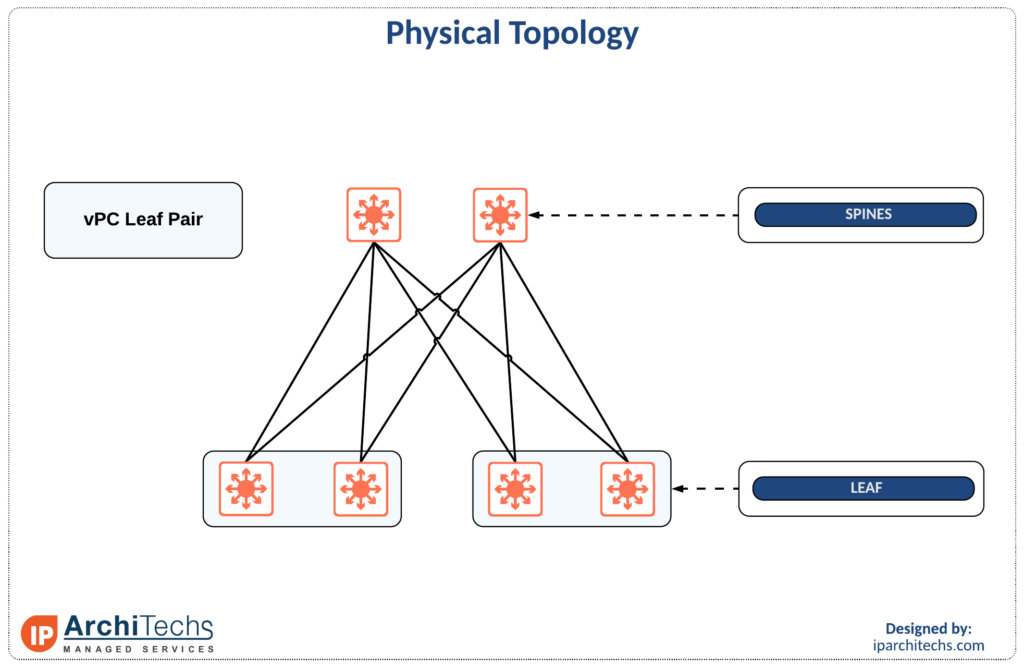

ISIS as an underlay routing protocol
Next you must decide on routing protocols. We will not examine layer 2 as this will be a completely routed fabric eliminating the need for any STP in your datacenter. Remember if you’re not Facebook, Amazon, Netflix, or Google (FANG) or some other webscaler you probably don’t have FANG problems i.e. there is no need to run a BGP underlay and learn to turn all the associated knobs to make that work; nor to engage in troubleshooting complex problems like path hunting.
For this reason we will look at utilizing Intermediate System to Intermediate System (ISIS) as an underlay with Internal Border Gateway Protocol (iBGP) as an overlay.
We prefer ISIS as an underlay network for data centers because:
- it is easier to scale than OSPF
- is extensible from the beginning (Type Length Values for additional capabilities)
- better stability at scale
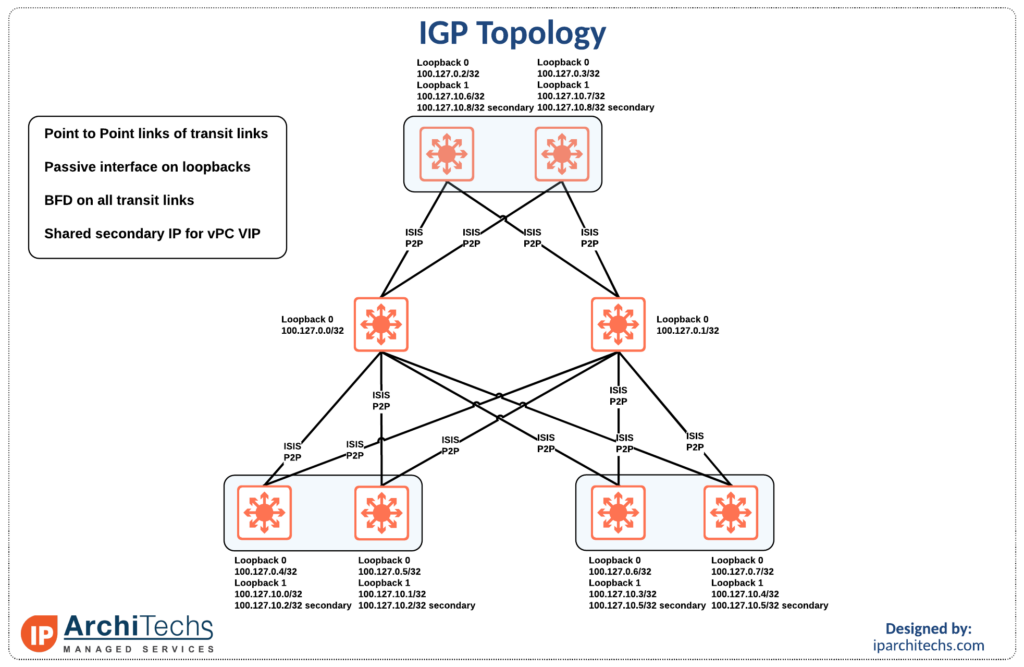
The secondary loopback is to enable the advertisement of a virtual IP address for traffic destined to the vPC pair. Single attached or routed links will advertise the physical IP address of the leaf so traffic returns the that specific leaf and not the pair.
iBGP as the overlay
The overlay is pretty straight forward. We will run iBGP with loopback peerings to exchange EVPN routes. EVPN scales significantly better than other VxLAN control plane protocols so we will not explore flood and learn or static assignment.
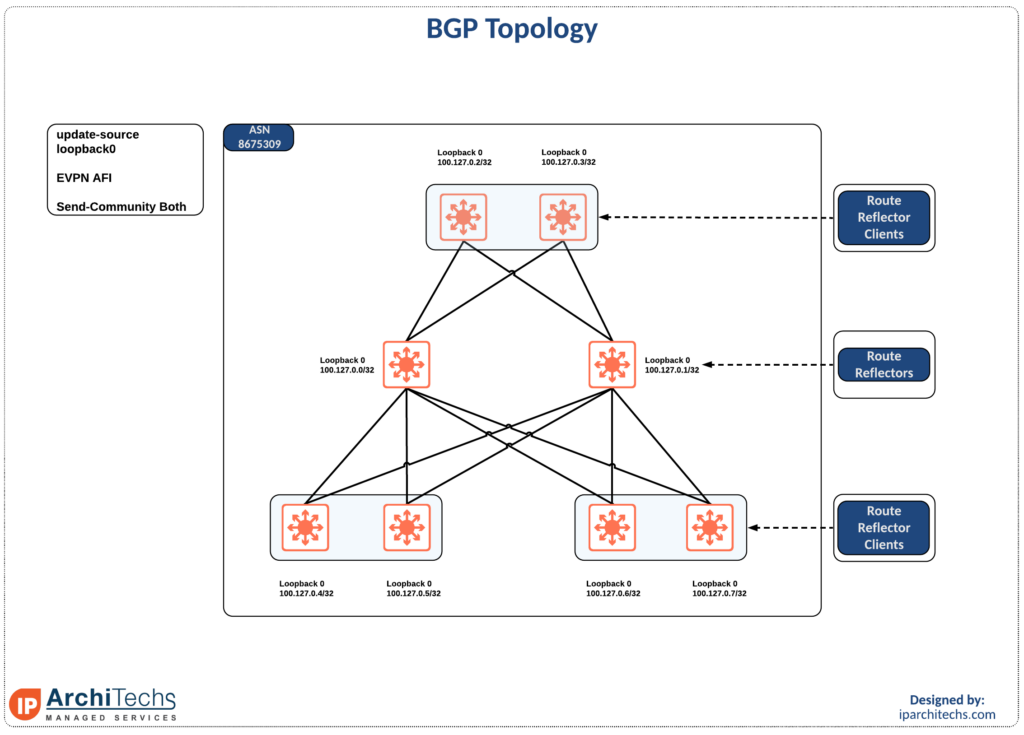
We will be utilizing vPC on the access layer for the remainder of the post. There are other methods for dual attached devices such as EVPN-multihoming but as this is cisco specific for fabricpath migrations they will not be discussed.
See an example configuration below of how the VIP/PIP mentioned earlier operate
Leaf BGP and NVE
interface nve1
no shutdown
host-reachability protocol bgp
advertise virtual-rmac ## for advertising the VIP
source-interface loopback1
router bgp 8675309
router-id 100.127.0.4
address-family l2vpn evpn
advertise-pip ## for advertising PIP if single attached
neighbor 100.127.0.0
remote-as 8675309
update-source loopback0
address-family l2vpn evpn
send-community
send-community extendedConnecting the current fabricpath DC and new fabric
The first thing to do is decide on the physical point of interconnection. You’ll want to ensure you chose a place you have enough ports to do a dual sided vPC with enough bandwidth to cover lateral traffic between new/old until the migrations are complete.
Next we have to think about the layer 2 protocols in play. Since spanning tree isn’t in play on either side we need to take special consideration to make sure we do not introduce a layer 2 loop.
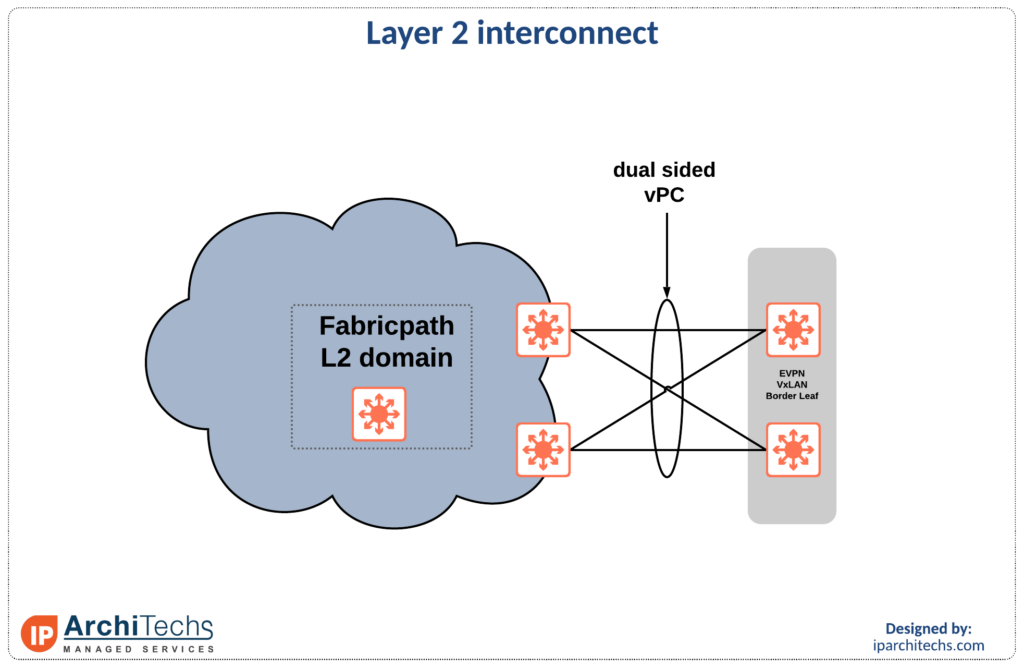
The EVPN/VxLAN side will not do anything with STP BPDUs but there is a requirement on the fabricpath side that it remains the root bridge. This is due to the entire fabricpath domain looking like one physical bridge. If a port in the fabricpath domain receives a superior BPDU a root-guard of sorts is enacted and the content edge port begins blocking.
Why do we care if STP doesn’t pass over the EVPN fabric? If the fabricpath environment is interconnected at two points then there will be a loop back to the fabricpath domain. This is a situation we want to avoid.
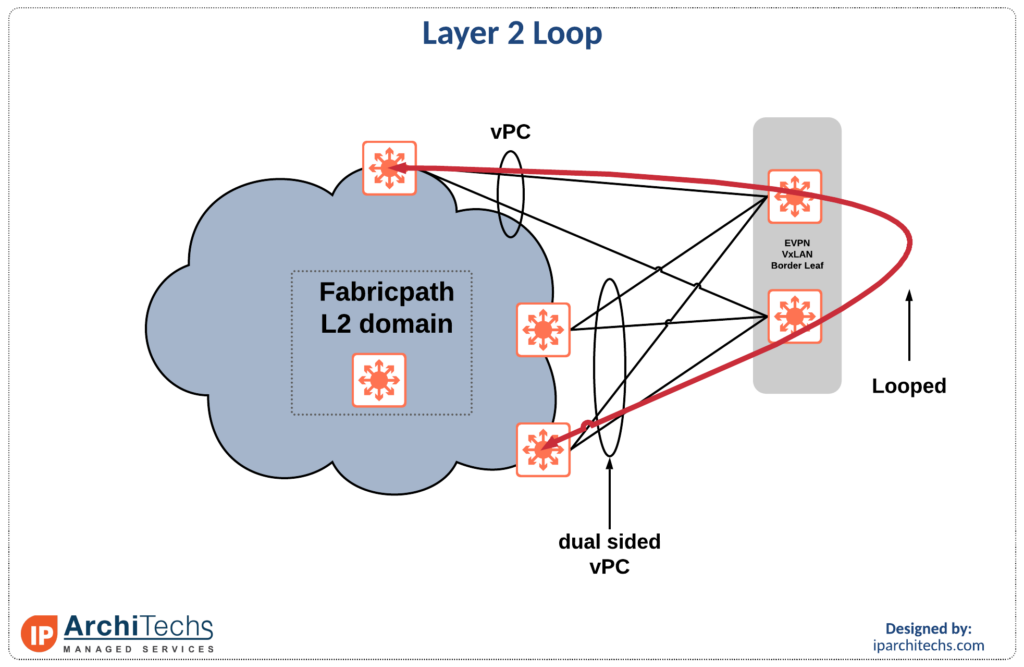
It can be avoided by:
- only having one interconnect
- manually pruning vlans at the two+ points of interconnect to ensure vlans remain on exactly ONE path
Migrating Switched Virtual Interfaces
Our preferred method of migrating SVIs from the old fabricpath environment to the new fabric is to:
- build all of the new Distributed Anycast Gateways (DAG) on the new fabric
- keep them shutdown
- establish a L3 adjacency via BGP for routing traffic back to exit points until the migrations are complete
- add the VLANs being migrated to the dual side vPC
- shutdown the SVIs on the fabricpath side and no shut the DAGs on the new fabric
- manually clear ARP on any hosts that did not update with the new DAG MAC
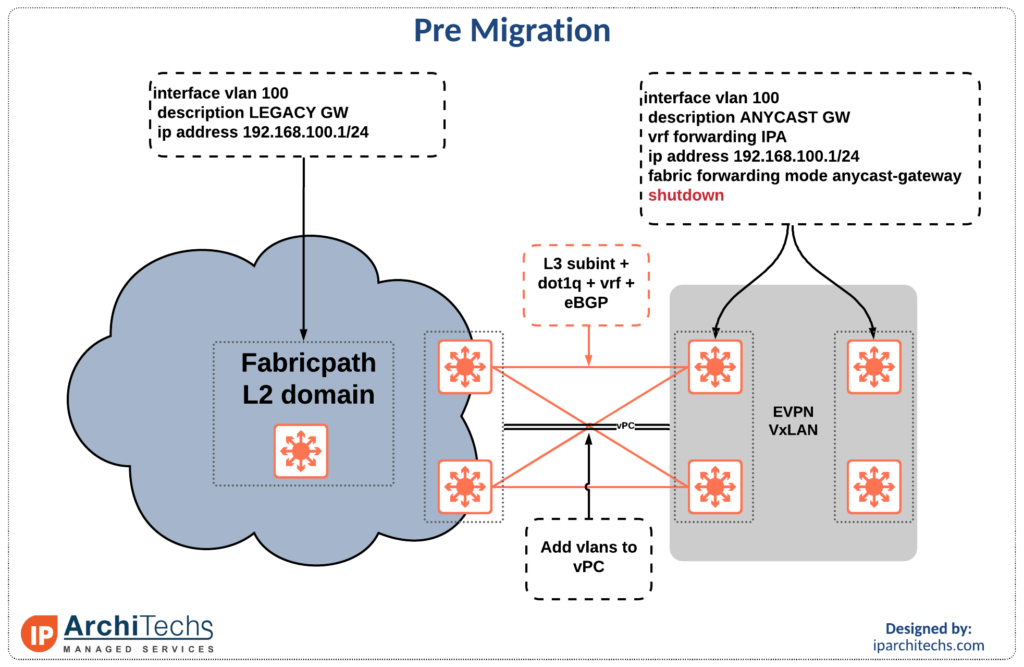
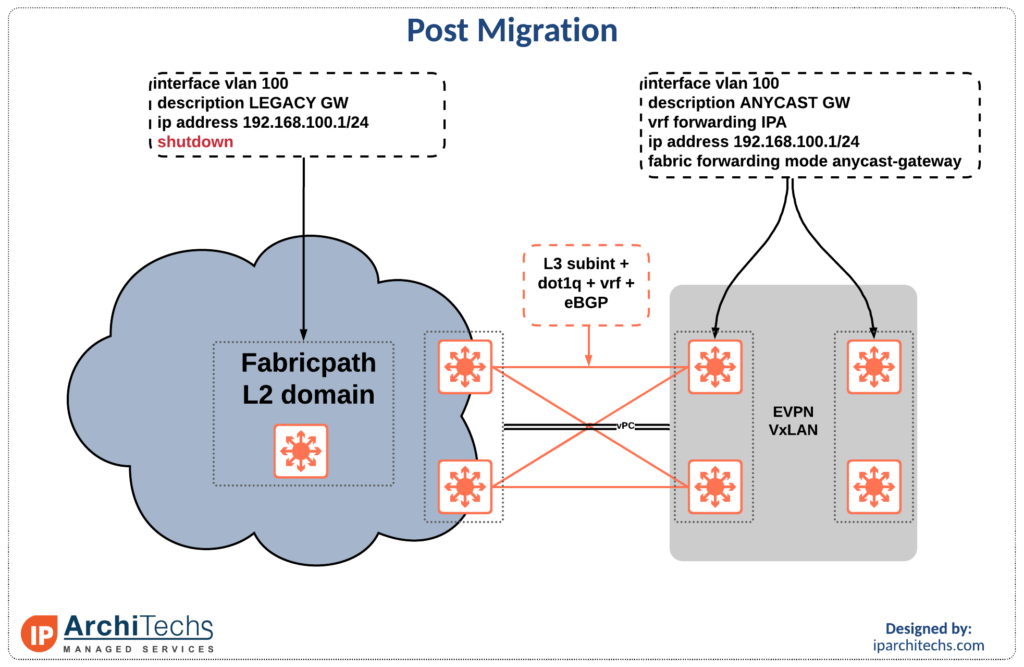
Migrating physical devices
Most of the physical devices are “easy” since there is no option but to physically move cables and you know this will result in a slight outage while the new uplinks come online.
However, with HA pairs of devices it is possible to migrate by moving the standby unit, waiting for the HA to reestablish, forcing a failover, move the active unit, and then “fail” back to the primary unit. This will test your HA setup as well as provide a seamless migration.
If you have new compute and storage you can migrate your workloads directly to the new environment and age out the legacy compute/storage.
Finally, ensure there are no more devices in use on your old environment and decommission the devices.
If you have questions or need assistance do not hesitate to reach out to us at ip architechs.
 +1 (855) 645-7684
+1 (855) 645-7684